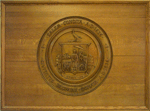McIntire, Samuel: Difference between revisions
No edit summary |
No edit summary |
||
| Line 14: | Line 14: | ||
==See Also== | ==See Also== | ||
*[http://www.salemweb.com/tales/mcintire.shtml Samuel McIntire] Salem Tales, SalemWeb.com | *[http://www.salemweb.com/tales/mcintire.shtml Samuel McIntire] Salem Tales, SalemWeb.com | ||
*[http://evergreen.noblenet.org/eg/opac/record/2583394?locg=63 Samuel McIntire: carving an American style] by Dean T. Lahikainen | *[http://evergreen.noblenet.org/eg/opac/record/2583394?locg=63 Samuel McIntire: carving an American style] by Dean T. Lahikainen | ||
Revision as of 11:31, 15 July 2015
Samuel McIntire (1757-1811), widely known for his woodcarvings, was also one of the first architects in the United States. Influenced by Boston's Charles Bullfinch, he gradually learned the profession after years as a master woodcarver. His architecture style is categorized as Federal Style.
Little is known about McIntire's personal life. He was born in Salem in 1757 and grew up in a family of housewrights. Samuel married Sally Fields in 1778, and the couple had one son.
He became well-known in Salem as an architect after Elias H. Derby hired him to design a home. McIntire went on to design more homes for Derby and soon became sought after by many wealthy Salemites.
Some of his famous buildings still standing are the Pierce-Nichols House, the Gardner-Pingree House and the Peabody-Silsbee House. Some of his public buildings are the Assembly Hall and Hamilton Hall.
See Also
- Samuel McIntire Salem Tales, SalemWeb.com
- Samuel McIntire: carving an American style by Dean T. Lahikainen
- The Wood-carver of Salem by Frank Cousins
- Mr. Samuel McIntire, carver, the architect of Salem by Fiske Kimball
- Essex Institute Historical Collection Vol. 93, p.113-222
